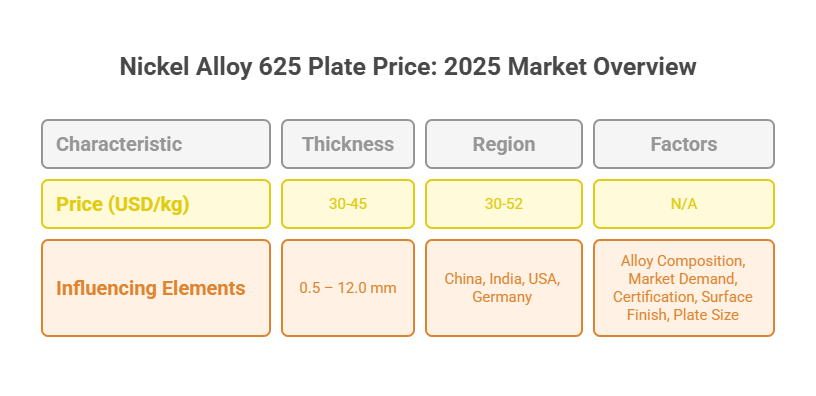Nickel Alloy 625 (UNS N06625) is a corrosion- and heat-resistant superalloy primarily composed of nickel, chromium, molybdenum, and niobium. Known for excellent fatigue strength, seawater resistance, and thermal stability, Inconel 625 plates are used in aerospace, chemical processing, marine, nuclear, and offshore oil industries. In 2025, the price of nickel alloy 625 plates varies based on thickness, surface finish, certifications, and supplier region. This guide presents current prices, size-based breakdowns, and cost factors for Alloy 625 plates.

Nickel Alloy 625 Plate Price by Thickness (USD/kg)
| Plate Thickness (mm) | Standard Size (mm) | Price Range (USD/kg) | Applications |
|---|---|---|---|
| 0.5 – 1.5 | 1000 x 2000 | 35 – 45 | Heat shields, flexible bellows |
| 1.5 – 3.0 | 1200 x 2400 | 33 – 43 | Heat exchangers, piping systems |
| 3.0 – 6.0 | 1500 x 3000 | 32 – 40 | Flanges, offshore structural parts |
| 6.0 – 12.0 | Custom cut | 30 – 38 | Pressure vessels, nuclear components |
Price by Region for Nickel Alloy 625 Plate (2025, USD/kg)
| Region | Typical Price (USD/kg) | Remarks |
|---|---|---|
| China | 30 – 38 | Best price for bulk industrial orders |
| India | 32 – 40 | Strong in pipe and plate exports |
| USA | 38 – 48 | Preferred for certified aerospace grades |
| Germany | 40 – 52 | High-spec plates with AMS/EN standards |
Factors Influencing Alloy 625 Plate Prices
1. Alloy Composition: Alloy 625 contains expensive elements like molybdenum (~9%) and niobium (~3.5%), increasing cost significantly.
2. Market Demand: Oil & gas and chemical sectors are driving strong demand in 2025, tightening supply and pushing prices upward.
3. Certification Requirements: Plates certified to NORSOK, ASTM B443, or ASME SB-443 command higher prices due to added testing.
4. Surface Finish: Ground, pickled, or mirror finishes may add 5–15% to the base plate cost compared to standard mill finish.
5. Plate Width and Length: Larger formats (1500 x 3000 mm or bigger) increase freight and packaging costs.
Alloy 625 Plate Weight and Estimated Cost by Size
| Size (mm) | Thickness (mm) | Weight (kg) | Estimated Price (USD) |
|---|---|---|---|
| 1000 x 2000 | 1.0 | ≈ 16 kg | 560 – 720 |
| 1200 x 2400 | 3.0 | ≈ 86 kg | 2800 – 3600 |
| 1500 x 3000 | 5.0 | ≈ 180 kg | 5700 – 7200 |
Buying Tips for Nickel Alloy 625 Plates
• Confirm Alloy Certification: Ensure the plate meets ASTM B443 or equivalent standards. Request MTC (Mill Test Certificate).
• Order in Bulk: Quantities above 500 kg typically receive 5–10% lower pricing at factory level.
• Choose Standard Dimensions: Standard widths like 1000, 1200, or 1500 mm avoid custom rolling surcharges.
• Consider Origin: Chinese mills offer the lowest price, while U.S. and European suppliers provide stricter certification.
Related Questions and Answers
How much does Alloy 625 plate cost per kg in 2025?
In 2025, nickel alloy 625 plate costs range from USD 30 to 45 per kg depending on region, thickness, and surface finish.
Why is Alloy 625 more expensive than other nickel plates?
Because it contains molybdenum and niobium, Alloy 625 offers superior high-temperature and corrosion resistance, making it more costly than pure nickel plates.
Where can I buy certified Alloy 625 plates?
Certified Alloy 625 plates are available from manufacturers in the USA, Germany, China, and India. Look for suppliers compliant with ASTM B443, ASME, or NORSOK standards.



